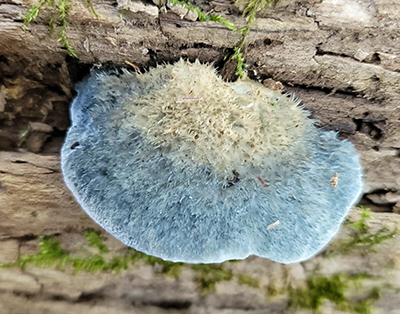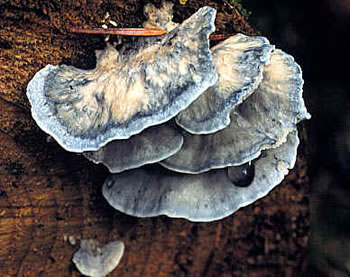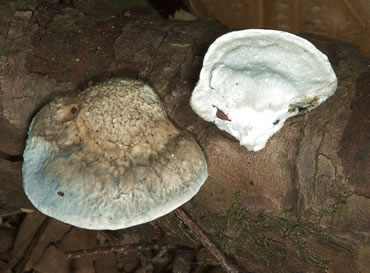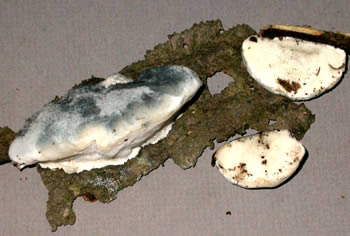Postia livens
Scientific name: Postia livens Miettinen & Vlasak
Derivation of name: livens means "grayish bluish"
Synonymy: Postia caesia (Schrad.) P. Karst.; Tyromyces
caesius (Schrad.) Murrill; Polyporus caesius Schrad.: Fr.;
Oligoporus caesius (Schrad.) Gilb. &
Ryvarden
Common names: Blue cheese polypore.
Phylum: Basidiomycota
Order: Polyporales
Family: Fomitopsidaceae
Occurrence on wood substrate: Saprobic; solitary on
decaying deciduous and conifer wood; August through
November.
Dimensions: Caps 1-8 cm wide
Upper surface: Whitish with grayish-blue tints, bruising blue;
hairy to glabrous.
Pore surface: White to grayish to bluish, bruising bluish;
pores 3-6 per mm.
Edibility: Inedible.
Comments: Odor fragrant. This polypore is soft, watery and
spongy when fresh.
In field guides, this species is often
listed as Tyromyces caesius or Postia caesia. The fungus
was transferred from Tyromyces to Postia because it is a
brown-rotter and Tyromyces species are white-rotters.
The name
P. caesia is now understood to be a European
species
that does not occur in North America. What was
called P. caesia in North America is now understood to be
a complex of five macroscopically similar species with
P. livens perhaps being the most common.

Figure 1. A
beautiful specimen of Postia livens. The bluish
coloration of most
specimens is not this spectacular.
Photo © John Dawson.

Figure 2. Blue cheese polypore. Fresh specimens are
soft and watery.
Photo © George Barron.

Figure 3. Postia livens on a dead branch. The pore
surface is whitish to pale gray. Photo © Dianna Smith.

Figure
4. Collected specimens with the grayish-blue
coloration
typical of this species.
Photo © Gary Emberger.